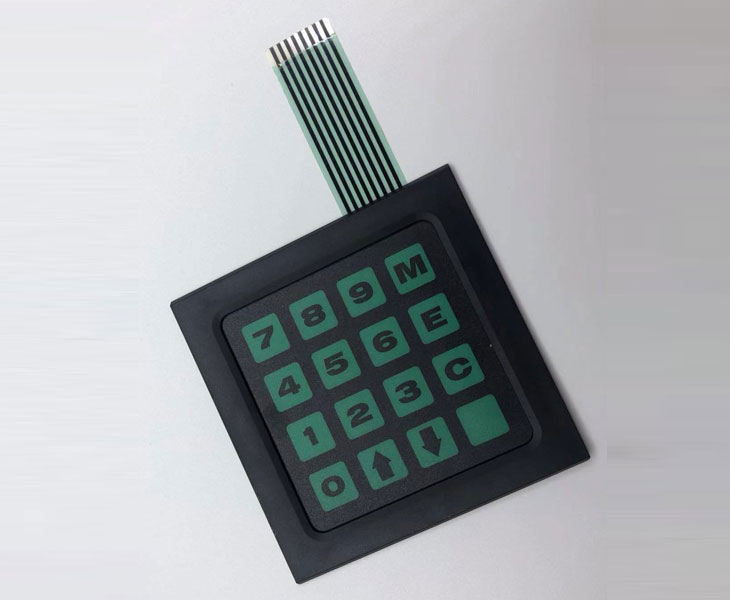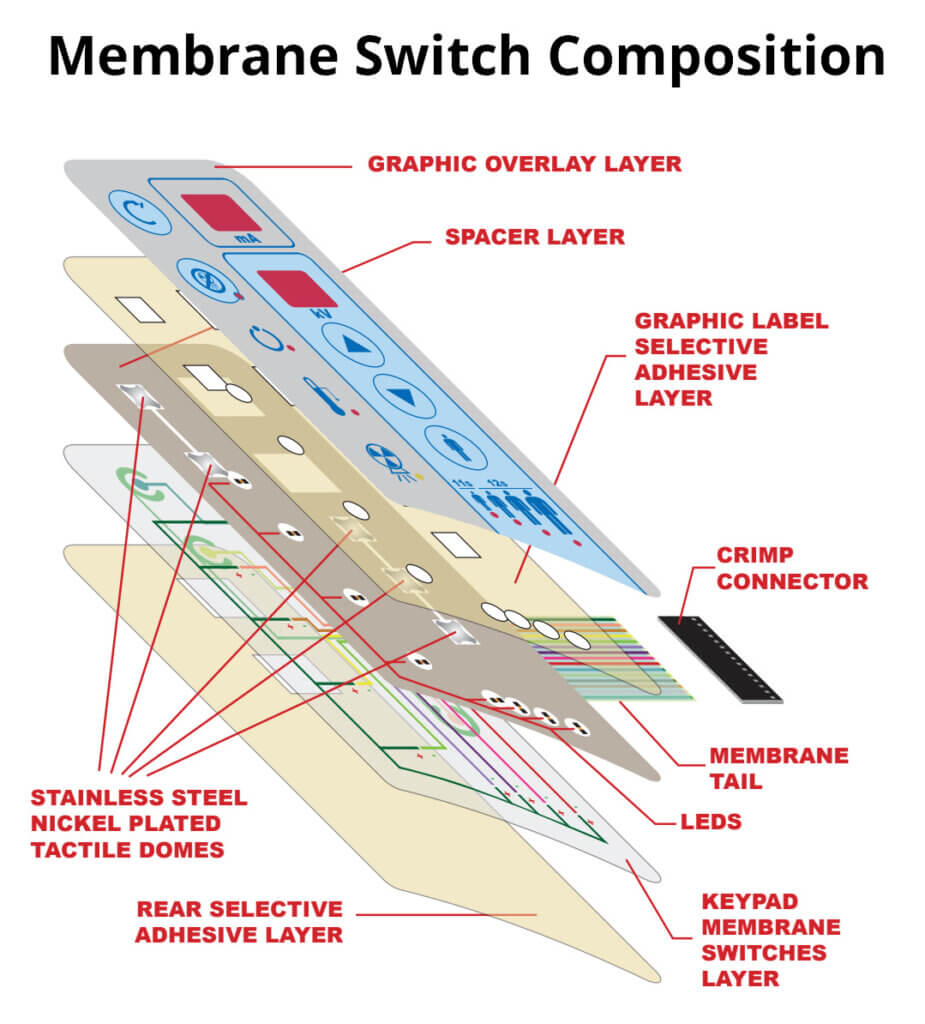Everything About Membrane layer Change: A Comprehensive Guide for Beginners
Membrane layer switches are important components in contemporary electronics, using a special interface for customer interaction - membrane switch. Their split building, consisting of overlays and conductive traces, supplies functionality and durability. Unlike standard mechanical switches, membrane buttons offer a smooth layout and customizable options. Recognizing their essential attributes and benefits can change product style. The intricacies of their application and style factors to consider require additional expedition.
What Is a Membrane Change?
A membrane layer button is a kind of electrical button that contains a flexible membrane layered over a published motherboard. This design enables a portable and sleek interface, commonly utilized in various electronic tools. Membrane layer switches are typically discovered in customer devices, clinical tools, and industrial machinery due to their resilience and resistance to environmental factors.The building normally consists of numerous layers, such as graphic overlays and adhesive backing, which offer responsive comments and secure the wiring below. The procedure of a membrane button is started when stress is put on the surface area, finishing an electric circuit.These switches are valued for their versatility, enabling personalized styles and printed graphics that cater to specific interface. Their low-profile nature reduces room needs, making them suitable for applications where traditional switches might not fit. Generally, membrane layer switches provide a practical and aesthetic solution for modern digital tools.
Secret Elements of Membrane Switches Over
Membrane layer changes comprise numerous key parts that add to their performance and performance. The top layer, understood as the overlay, offers the user interface and is usually printed with symbols or graphics. Under the overlay lies a spacer layer, which separates the conductive aspects and avoids inadvertent activation. The following important part is the graphic layer, which enhances aesthetic appeals and guarantees the durability of the design.Conductive traces, generally made from materials like silver or carbon, are published on the circuit layer. When pressure is used to the overlay, these traces enter into get in touch with, completing the circuit. In addition, a backing layer uses structural support and can be made from materials such as polyester or polycarbonate. With each other, these components produce a reliable, user-friendly user interface appropriate for numerous applications, from household devices to commercial equipment. Recognizing these elements is crucial for anybody curious about membrane button modern technology.
How Membrane Layer Switches Over Work
Comprehending just how membrane changes feature is essential for appreciating their prevalent usage in various gadgets. A membrane layer button operates with a collection of layers, consisting of a graphic overlay, spacer, and a circuit layer. When pressure is used to the overlay, it presses the spacer layer, allowing the circuit layer to make contact and complete an electric circuit. This activity sends out a signal to the device, triggering a response, such as switching on a light or triggering a function.Membrane switches over can be designed with various functions, including responsive comments, backlighting, and personalized graphics, boosting customer interaction. Their building permits a closed style, securing the inner parts from dirt, dampness, and impurities. This resilience makes them appropriate for diverse applications, from consumer electronics to industrial equipment. Generally, the simplicity and efficiency of membrane layer changes contribute to their popularity in modern technology.
Advantages of Membrane Layer Switches Over Over Mechanical Buttons
While mechanical switches have actually long been a staple in lots of gadgets, membrane switches offer distinctive benefits that make them progressively appealing. One considerable benefit is their slim profile, permitting even more small styles and greater flexibility in item advancement. Furthermore, membrane switches over function an uniform surface area, which improves aesthetic allure and streamlines cleaning, making them ideal for settings where hygiene is critical.Another benefit is their resistance to dirt and moisture. Unlike mechanical buttons, which can be jeopardized by environmental variables, membrane layer switches give a closed interface that shields against contaminants - membrane switch. Membrane layer switches normally have a longer lifespan due to less relocating parts, resulting in boosted resilience and reliability.Cost-effectiveness is additionally a noteworthy advantage, as membrane buttons can be produced in bulk with reduced production prices. These variables integrate to place membrane layer buttons as a practical choice to typical mechanical choices in various applications
Typical Applications of Membrane Layer Changes
Membrane layer buttons are widely utilized in numerous sectors, especially in customer electronic devices and commercial control panels. In consumer gadgets, they give a sleek, easy to use user interface, while in commercial setups, they boost sturdiness and capability. Comprehending these applications highlights the convenience look at here now and practicality of membrane switches in modern technology.
Consumer Electronics Tools
As customer electronic devices remain to advance, membrane layer buttons have actually come to be a preferred choice for a variety of devices due to their flexibility and sleek design. These switches are typically found in smartphones, tablets, and remote controls, where space is limited and looks issue. Their low profile and customizable designs allow manufacturers to develop straightforward user interfaces that improve the general user experience. Additionally, membrane layer buttons are frequently made use of in devices such as microwaves and coffee machine, supplying user-friendly control options while resisting dampness and dust. The sturdiness and dependability of membrane layer switches make them suitable for daily customer items, making certain long life and constant performance. On the whole, their combination in consumer electronic devices shows a blend of capability and contemporary design.
Industrial Control Panels
The applications of membrane layer switches expand beyond customer electronics, finding considerable use in commercial control panels. These buttons are favored for their durability and resistance to rough atmospheres, making them perfect for making and process control setups. They offer a dependable user interface for operators to manage machinery, screen procedures, and change setups. Membrane buttons can be customized to fit certain operational demands, incorporating attributes like backlighting and tactile comments, boosting user experience. Their inconspicuous layout permits assimilation into different tools, while their ability to stand up to spills, dirt, and extreme temperature levels warranties longevity. Generally, membrane layer switches add to safe and effective procedure in commercial applications, demonstrating their flexibility and performance in requiring atmospheres.
Considerations for Creating Membrane Layer Switches
When developing membrane layer buttons, picking the right materials is necessary to assure resilience and performance. Furthermore, recognizing layer arrangement strategies can greatly influence the button's performance and user experience. These considerations play a crucial duty in developing reliable and dependable membrane switch designs.
Material Option Relevance
Product option plays an essential role in the layout and capability of membrane layer buttons. The selected materials directly affect the button's durability, responsive feedback, and total aesthetic. Trick factors to consider consist of the substratum, which have to provide structural integrity while enabling versatility, and the graphic overlay, which needs to be resistant to use and ecological factors. Conductive materials ought to ensure trusted electric efficiency, while adhesives need to use strong bonding without compromising the switch's operation. In addition, compatibility with making processes and end-user settings is crucial; materials have to stand up to varying temperatures, moisture degrees, and chemical exposure. Inevitably, appropriate product choice not just improves the membrane layer button's performance however also adds to its long life and individual fulfillment, making it an essential element of the layout procedure.

Layer Configuration Methods

Frequently Asked Concerns
The Length Of Time Do Membrane Layer Switches Over Usually Last?
Membrane layer switches usually have a life expectancy of 1 to 5 million cycles, depending on usage and ecological problems. Elements such as style quality and operating regularity significantly affect their sturdiness and total performance durability.

Can Membrane Changes Be Customized for Details Layouts?
Membrane switches can without a doubt be personalized to fit specific layouts, enabling diverse forms, colors, and functionalities. This convenience allows producers to customize these switches to meet special aesthetic and functional demands effectively.
What Products Are Used in Membrane Layer Change Construction?
Membrane layer switches are commonly constructed making use of materials such as polyester, polycarbonate, and sticky layers. These products provide longevity, flexibility, and resistance to ecological elements, making sure the buttons function efficiently in different applications and problems.
Are Membrane Layer Switches Resistant or water resistant to Dampness?
Membrane layer buttons can be designed to be moisture-resistant, utilizing specialized finishes and products. Their water resistant abilities depend on building high quality and certain applications, making it necessary to examine requirements for ideal performance in various settings.
Just How Are Membrane Layer Changes Repaired if Damaged?
Fixing broken membrane layer changes usually involves replacing the affected layer or circuit. Professionals might likewise apply conductive sticky or use specialized repair packages, making certain capability is brought back without complete substitute of the whole switch assembly. Unlike typical mechanical buttons, membrane buttons provide a sleek design and personalized choices. A membrane button is a type of electric button that consists of a flexible membrane layered over a published circuit board. The procedure of a membrane switch is initiated when stress is used to the surface area, completing an electric circuit.These switches are valued for their convenience, making it possible for custom-made styles and published graphics that cater to particular user interfaces. While mechanical switches have long been a staple in numerous gadgets, membrane changes deal distinct benefits that make them significantly appealing. Membrane layer switches normally have a longer life expectancy due to fewer relocating components, resulting in improved sturdiness and reliability.Cost-effectiveness is additionally a notable benefit, as membrane layer switches can be generated in bulk with lower production prices.
Comments on “The evolution of membrane switch in aerospace applications”